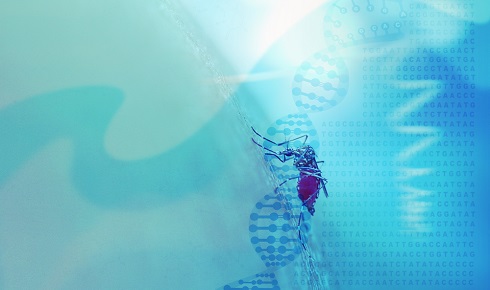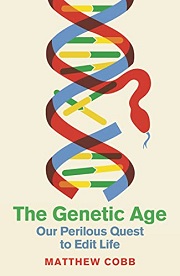Dangerous drivers

An exclusive book extract from award-winning author Matthew Cobb FRSB explores the potentially dangerous power of gene drives
September 12th 2022
Matthew Cobb FRSB is a professor of zoology at the University of Manchester and a member of The Biologist’s editorial board.
In his latest book, The Genetic Age: Our Perilous Quest to Edit Life, Matthew Cobb (The University of Manchester) looks at the advances in genome engineering over the last half a century, and the world-changing possibilities of the latest genetic technology – sometimes awe-inspiring and hopeful, sometimes more worrisome.
In this exclusive extract Cobb looks at gene drives – genetic elements engineered by scientists to be transmitted at super-Mendelian frequencies. In other words, a way to spread genetic changes through a group of organisms so that the genetically altered individuals quickly dominate wild populations.
Extract from The Genetic Age
by Matthew Cobb FRSB
Insects can transmit terrible diseases and devastate crops. Genetic engineering now promises to fix this by altering whole species through artificial genetic elements called gene drives that sweep through a population, copying themselves madly from generation to generation. This explosive potential could be used to make mosquitoes unable to transmit malaria or it could eliminate them entirely from a region.
The idea has been around for nearly 20 years. In 2003 Austin Burt of Imperial College theorised that a gene that produces a DNA-cutting enzyme (an endonuclease) targeted to the gene that encodes it could increase exponentially even from a single copy. It would work like this: soon after fertilisation the nuclease cuts the DNA sequence on the chromosome that does not carry the gene. The cell’s DNA repair mechanisms then uses the intact chromosome as a template to reconstruct the damaged sequence. Where there was only one copy of the gene, there are now two, one on each chromosome.
The same thing would happen in all the offspring of that individual and the gene’s frequency in the population grows exponentially, flooding the population. Burt realised that by attaching one of these genes to a gene that would alter the target animal – for example, by inducing sterility or making a mosquito immune to malaria – it would theoretically be possible to ‘drive’ that character into every member of a population.
With the advent of CRISPR gene editing in 2013 Kevin Esvelt of Harvard realised how to make this a reality and also recognised the dangers. He told me: “I was absolutely terrified because I had realised that individual researchers in their labs, if they knew how to edit the genome of a relevant organism with CRISPR, they would have the power to do so, and let it go, and it would spread to affect everyone. So I actually didn’t tell anyone – even my supervisor – for over a month.”
The first CRISPR-based gene drive was created in 2014 by geneticists in San Diego simply because they needed lots of extra Drosophila flies with a set of genes that interested them. Once they realised the potential dangers of what they had done, they hesitated about whether to publish their finding. According to the title of their article they had created a ‘mutagenic chain reaction’. To put it another way, they had made a genetic atom bomb. Gene drives do not work only in Drosophila. Researchers at Imperial College have created mosquito gene drives that stop egg production. In near-natural laboratory conditions a large population of mosquitoes disappeared in less than a year.
 Biologist Kevin Esvelt was the first to create an artificial gene drive, and immediately worried about its potential uses.
Biologist Kevin Esvelt was the first to create an artificial gene drive, and immediately worried about its potential uses. This technology needs to be regulated by an authority with a global reach like the International Civil Aviation Organization, which enables us to fly in relative safety wherever we are in the world. But this was set up in 1947 when all countries had an appetite for international regulation. That is no longer the case. The United Nations Convention on Biological Diversity is one possible body that could regulate gene drives, but the US has not signed up, nor is it likely to.
There are other regulatory routes. In June 2021 the WHO recommended that gene drive projects be co-developed with local communities, including a series of checkpoints that could lead to the project being abandoned. An example of what this might look like can be seen in a series of workshops in Africa organised by Imperial College researchers funded by Target Malaria, a research consortium backed by the Bill and Melinda Gates Foundation. They identified eight major ecological problems that could occur through 46 pathways. Each of these possibilities would have to be field-tested before any deployment.
Obtaining what is called free, prior and informed consent from affected local communities is essential, but difficult. The community needs be able to question fundamental aspects of the project, including exploring alternative means to achieve the desired end. This is particularly important where people might be rightly wary of scientists in white coats, given a past history of colonialist medical interventions.
 A number of groups are working toward the release of mosquitos engineered with gene drives, despite less ecologically risky alternatives, such as vaccines, showing promise.
A number of groups are working toward the release of mosquitos engineered with gene drives, despite less ecologically risky alternatives, such as vaccines, showing promise. The Genetic Age: Our Perilous Quest to Edit Life is out now via Profile Press.



